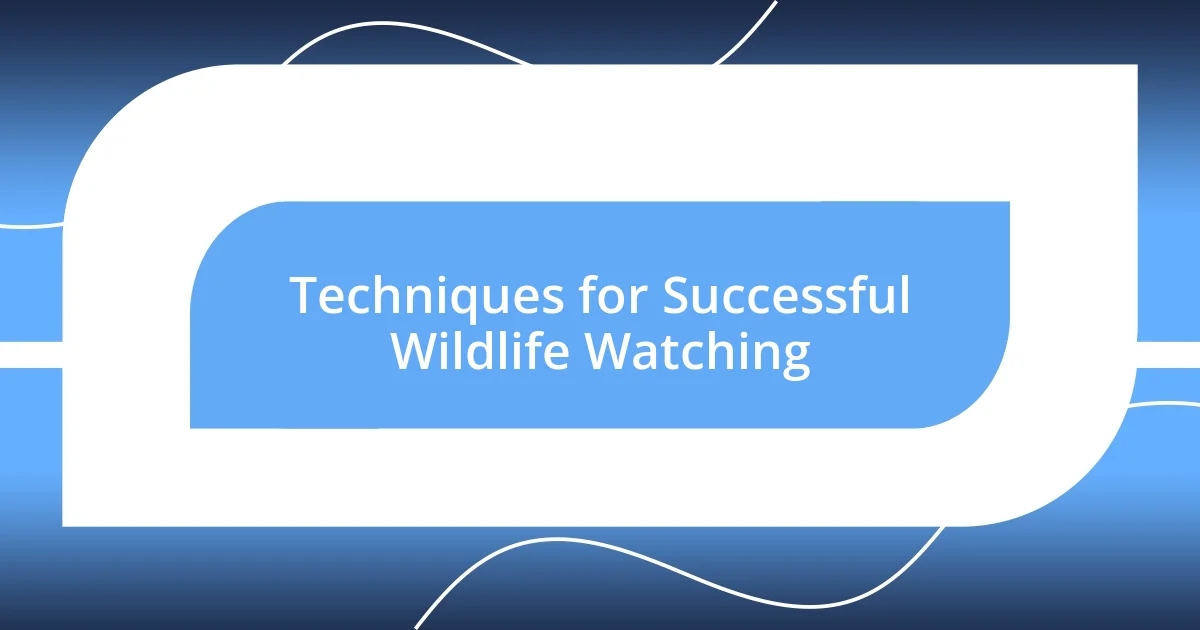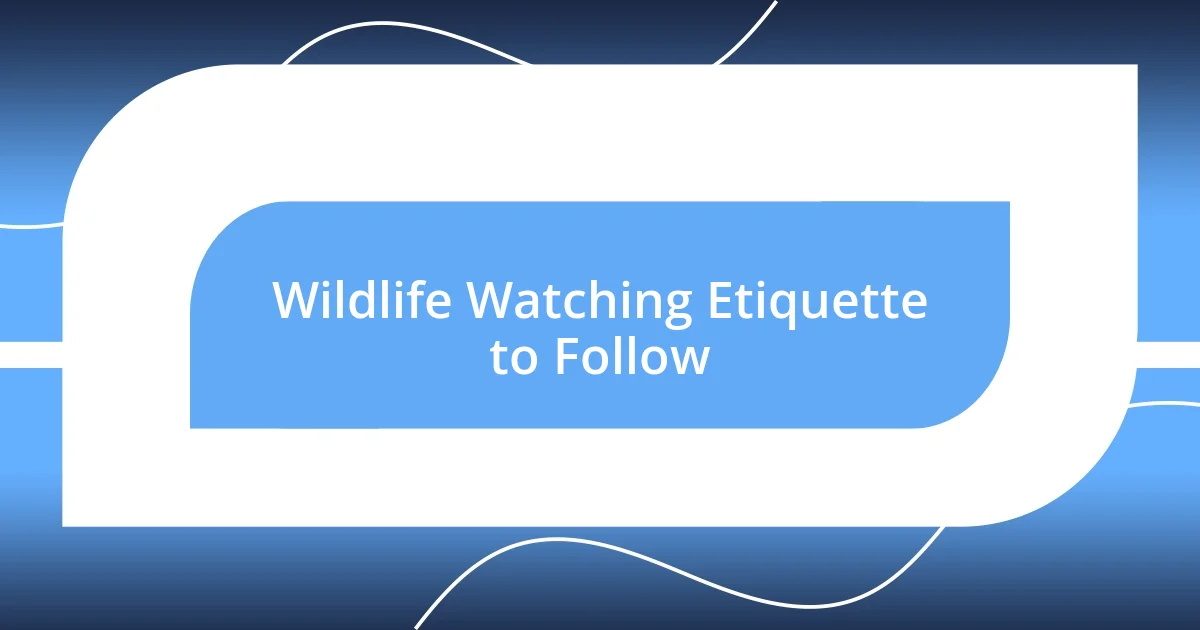Key takeaways:
- Wildlife watching offers a deep connection to nature, enhances well-being, and fosters a sense of responsibility for conservation.
- Essential gear for successful wildlife watching includes binoculars, a camera, a field guide, comfortable clothing, and snacks.
- Patience, understanding animal behavior, and capturing moments during optimal lighting are crucial techniques for a rewarding wildlife experience.

What is Wildlife Watching
When I think about wildlife watching, I picture those quiet moments where nature unfolds its beauty right before my eyes. It’s not just about observing animals in their habitats; it’s an immersive experience that connects us to the very essence of the world around us. Have you ever felt your heart race when spotting a majestic eagle soar overhead?
Wildlife watching often takes place in various environments, from dense forests to open savannas, offering endless opportunities for discovery. I remember the thrill of standing silently by a riverbank, waiting for the splash of a fish or the ripple of a deer drinking. That anticipation adds an electrifying element to the experience, making the moment even more rewarding when it finally occurs.
This activity encourages us to slow down, observe, and reflect on the intricacies of nature. I’ve found that every outing teaches me something new, whether it’s the subtle behaviors of animals or the delicate balance of ecosystems. What lessons might you discover on your next wildlife adventure? There’s always something deeply fulfilling about witnessing life in its most natural form, a reminder of our responsibility to cherish and protect these wonders.

Why Go Wildlife Watching
When I think about wildlife watching, I realize it’s much more than just spotting animals; it’s about the connection it fosters between us and the natural world. I remember a serene afternoon spent in the wetlands, where I watched a family of otters playfully glide through the water. Their joy and energy were infectious, reminding me of the simple pleasures in life. What can be more enchanting than witnessing these moments firsthand, where every snap of a twig or rustle of leaves holds the promise of a new discovery?
The health benefits of wildlife watching are astounding, too. Studies show that immersing ourselves in nature can reduce stress levels and improve overall well-being. I’ve often found solace in nature’s embrace, where the sounds of rustling leaves and chirping birds create a soothing atmosphere. Have you ever noticed how your worries fade when you’re surrounded by nature? Those peaceful moments allow mind and body to reconnect, leading to a sense of clarity and peace.
Moreover, wildlife watching promotes an understanding of biodiversity and conservation. Each species we encounter plays a vital role in its ecosystem, reminding us of the interconnectedness of all life on Earth. On a memorable trip to a national park, I observed a mother bear with her cubs foraging for food. Watching them thrive in their habitat instilled a deeper appreciation for wildlife and solidified my commitment to protecting these precious environments. How can we not feel compelled to act when faced with such beauty?
| Benefits | Wildlife Watching |
|---|---|
| Connection to Nature | Fosters awareness and appreciation for the environment. |
| Health Improvements | Reduces stress and boosts mental well-being. |
| Conservation Awareness | Promotes understanding of biodiversity and inspires protective actions. |

Essential Gear for Wildlife Watching
When preparing for a wildlife watching adventure, having the right gear can make all the difference. I’ve learned this firsthand on excursions where I forgot a crucial item and missed out on incredible opportunities to connect with nature. Being properly equipped not only enhances your experience but also ensures you’re ready for anything the wild presents.
Here’s a list of essential gear I recommend bringing along:
- Binoculars: A good pair enhances details of distant animals, making your experience more memorable.
- Camera: Capturing the moment allows you to relive those magical encounters later.
- Field Guide: Having a guidebook helps identify species and deepens your understanding of the wildlife around you.
- Comfortable Clothing: Dress in layers to adapt to changing weather conditions; comfort is key during long hours outdoors.
- Water and Snacks: Staying hydrated and fueled keeps your energy up and your spirit high during long hikes.
My own mishap with binoculars taught me how vital they are; I almost missed a breathtaking sighting of a rare bird because I left mine behind. Carrying these essentials not only prepares me physically but also elevates the emotional experience, allowing me to savor every moment in the wild.

Techniques for Successful Wildlife Watching
Wildlife watching is an art that requires a blend of patience and keen observation. I remember sitting quietly on a rocky ledge, watching for signs of movement. The thrill of spotting a deer, the way it cautiously stepped into view, emphasized how remaining silent and still can reward you with some of the most breathtaking moments. Have you ever witnessed that magic unfold in front of you?
Timing is everything in wildlife watching. There are those golden hours just after dawn and before dusk when animals are most active. On one of my early morning excursions, the world was still shrouded in mist, creating an eerie yet captivating atmosphere. It was at that moment that I encountered a family of foxes, their playful antics illuminating the tranquility of the morning light. Isn’t it amazing how the right timing can align perfectly with nature’s rhythm?
I’ve also discovered that blending into your surroundings can dramatically enhance your experience. When I wore earthy tones and moved slowly, I felt like I was part of the landscape. This technique allowed me to observe a magnificent eagle soar above me without disturbing its flight. There’s something beautiful about becoming one with nature, allowing us to witness wildlife in its purest form. Isn’t it exhilarating to know that with a few simple adjustments, we can open ourselves to the wild’s wonders?

Wildlife Watching Etiquette to Follow
Wildlife watching is as much about respect as it is about enjoyment. One memorable encounter taught me the importance of keeping my distance. I found myself mesmerized by a family of deer grazing peacefully, yet I stayed at a respectful range. The moment I observed them from afar, I felt a connection, as if I was an unseen guest in their world. Have you ever just paused to take in the beauty of something without interfering? That stillness and space allowed them to thrive, and it deepened my appreciation for their natural behaviors.
Speaking of respect, I’ve learned that noise can significantly disrupt the serenity of wildlife experiences. On a trip to a national park, a group of exuberantly loud hikers startled a flock of birds I had been trying to observe for quite some time. It was frustrating, but it reminded me of the delicate balance we must maintain. When I finally sat quietly with a few fellow enthusiasts who understood, we were rewarded with the sight of a majestic hawk swooping down, undisturbed by our presence. Isn’t it incredible how a little mindfulness can make all the difference in our interactions with nature?
Lastly, I’ve found that leaving no trace is crucial while wildlife watching. I’ve made it a habit to carry out any trash I find and to stay on marked trails whenever possible. One particularly poignant moment occurred when I noticed a colorful bag left behind on the path; it felt like an intrusion into the pristine environment. Taking that bag with me not only helped the ecosystem, but it also gave me a profound sense of responsibility. How can we truly cherish and enjoy our wildlife experiences if we don’t protect their habitats? That’s a question I ponder whenever I step into nature, reinforcing my commitment to be a conscientious observer rather than just a visitor.

My Personal Wildlife Watching Experience
Wildlife watching holds a special place in my heart. I vividly recall the first time I spotted a mother bear with her cubs, clumsily navigating through the underbrush. My heart raced with a mix of awe and fear as they stumbled closer, their playful interactions a stark reminder of the wild’s unpredictability. Can you imagine the thrill of witnessing such a raw moment in nature? It made me realize how vital it is to approach these experiences with both wonder and caution.
On another occasion, I found myself nestled in a small canoe, gliding silently across a tranquil lake at sunrise. The world around me came alive as the mist began to dissipate, revealing a family of otters at play. I felt a warmth spread through me, knowing that I was a mere observer of this magic. Isn’t it remarkable how nature invites us into its stories if we take the time to listen and watch? It’s these moments that forge an emotional connection, deepening my appreciation for wildlife and its intricate tales.
I also learned that patience is not just a virtue, but often a wildlife watcher’s best friend. After hours of scanning the treetops for an elusive owl, I began to feel disheartened. Just as I was about to give up, a soft hoot echoed through the stillness, and there it was—perched majestically upon a branch. The thrill of that moment made all the waiting worthwhile. Have you ever felt that tingle of excitement after a long pursuit? It’s in those fleeting seconds that the beauty of wildlife watching truly reveals itself.

Tips for Capturing Wildlife Moments
Capturing wildlife moments can be magical, but it also requires a bit of strategy. I always recommend having the right gear at hand. Once, during a trip to a rainforest, I ventured out with my trusty DSLR camera and a telephoto lens. The lens allowed me to snap stunning close-ups of a vibrant toucan without intruding on its space. Isn’t it amazing how the right equipment can turn a fleeting moment into a lasting memory?
Another tip I swear by involves understanding animal behavior. Paying attention to patterns can significantly increase your chances of spotting wildlife. On one unforgettable evening, I noticed a herd of elephants returning to a waterhole like clockwork. By simply observing their daily rituals, I positioned myself accordingly and captured breathtaking images of them splashing in the water. Have you ever considered how patient observation transforms the ordinary into extraordinary?
Lastly, lighting can make or break your wildlife photos. Early morning and late afternoon are often referred to as the golden hours for a reason. I remember waking before dawn to catch the sunrise over a savannah; the soft light illuminated a pride of lions just waking from slumber. Those moments become more than just photographs; they become storytelling canvases. Don’t you think there’s something truly enchanting about the way light interacts with nature? It’s worth timing your outings to capture that magic.













